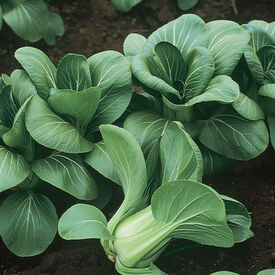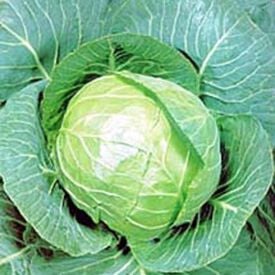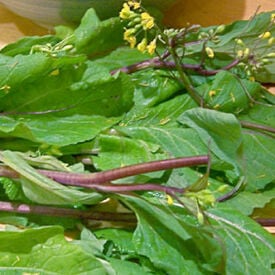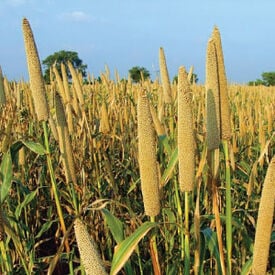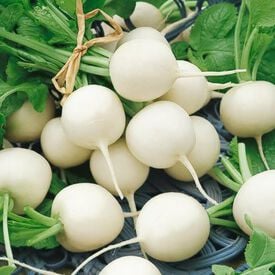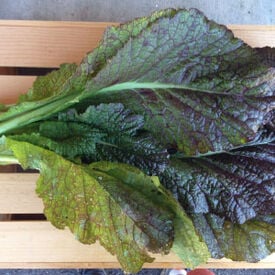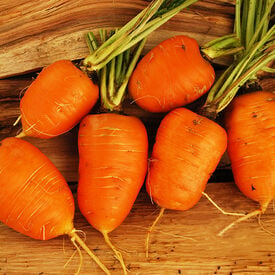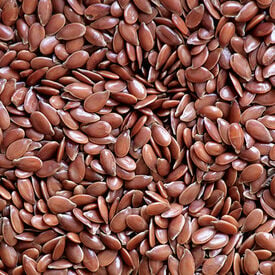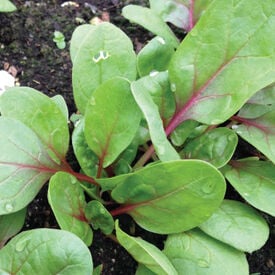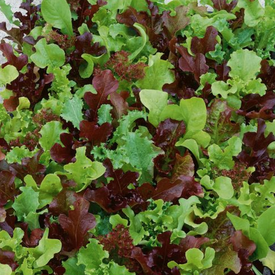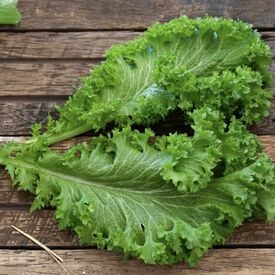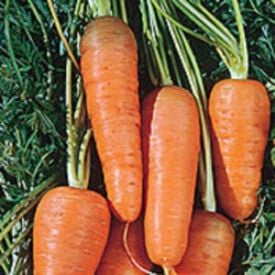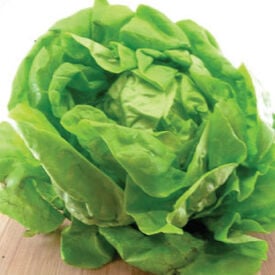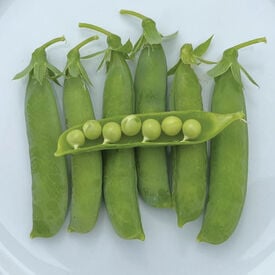Dark green crumpled leaves, approximate 7 x 9 in. head, 6-8 lb, even better flavor after touched by frost, very tender.
Rouge D'Hiver Lettuce is a beautifully multicolored French heirloom romaine. This variety's green leaves are tinted with medium-red color at the tip. Rouge D'Hiver is not just beautiful, but it is also very tasty and very easy to grow. This lettuce is a home favorite for resisting heat and cold stress if well watered. This variety has been recently resurrected.
How to Plant:Till ground before planting. Then firm ground to make flat. Use a seed broadcaster to spread seed evenly over the ground. Next flatten ground again to secure seeds into soil.How to Plant:Till ground before planting. Then firm ground to make flat. Use a seed broadcaster to spread seed evenly over the ground. Next flatten ground again to secure seeds into soil.Seeding Rates:Sowing SeasonSeeding DepthSeeding Rate (1,000 Sq. Ft.)Seeding Rate (1 Acre)AmaranthSpring & Summer1/4 - 1/2"1 lb.15-25 lbs.BarleySpring & Summer3/4 - 2"2 lbs.75-125 lbs.BuckwheatSpring & Summer1/2 - 1 1/2"2-3 lbs.50-100 lbs.MilletSummer1/2 - 1"1/4 lb.6-10 lbs.OatsSpring & Summer1/2 - 1 1/2"4 lbs.100-150 lbs.Rye, WinterAnytime3/4 - 2"4 lbs.75-125 lbs.RyegrassAnytime0 - 1/2"1 lb.25-50 lbs.SudangrassSpring & Summer1/4 - 1/2"1-2 lbs.35-65 lbs.WheatSpring1/2 - 1 1/2"4 lbs75-150 lbs.Sowing SeasonSeeding DepthSeeding Rate (1,000 Sq. Ft.)Seeding Rate (1 Acre)AmaranthSpring & Summer1/4 - 1/2"1 lb.15-25 lbs.BarleySpring & Summer3/4 - 2"2 lbs.75-125 lbs.BuckwheatSpring & Summer1/2 - 1 1/2"2-3 lbs.50-100 lbs.MilletSummer1/2 - 1"1/4 lb.6-10 lbs.OatsSpring & Summer1/2 - 1 1/2"4 lbs.100-150 lbs.Rye, WinterAnytime3/4 - 2"4 lbs.75-125 lbs.RyegrassAnytime0 - 1/2"1 lb.25-50 lbs.SudangrassSpring & Summer1/4 - 1/2"1-2 lbs.35-65 lbs.WheatSpring1/2 - 1 1/2"4 lbs75-150 lbs.Cover Crop Calculator:Calculate the amount of cover crop neededCover Crop Calculator:Calculate the amount of cover crop needed1 Acre = 43,560 square feet, or 435'x100'Weight Conversion:1 Pound = 16 Ounces
Mei Qing Choi cabbage is a Shanghai pak choi type with good heat and cold tolerance and bolting resistance. In the U.S., this variety is harvested as baby pak choi. It is smaller than Joi Choi, weighing about a quarter of a pound. This pak choi has an excellent flavor and is extra tender.
The Golden Acre is a tasty cabbage that arrives early and is suited for close spacing. This early round head cabbage is easily grown and versatile in use. Heads are about 6 to 7 inches in diameter on compact plants about a foot high. Its firm, medium green head is excellent cooked or raw in stews and salads.
The Hon Tsai Tai has deep purple tender stalks with a slight mustard flavor that is great in different salads or cooked into stir fries! Its green leaves have petite florets that are best harvested right before the bright yellow blossoms open. Hon Tsa Tai is best grown in mid to late summer.
The Pearl Millet is a very tall grass that can reach to be 15 feet tall that is used as a multiple cut forage grass and green manure. This grass is high in protein, digestible and free of prussic acid. The Pearl Millet is perfect used for hay, pasture and silage for feeding cattle, horses, goats and other livestock. The Pearl Millet is also a very good green manure that is well adapted to low soil moisture, low fertility and high temperatures. Uses: Erosion Control, Green Manure, Nitrogen Scavenger, No Till, Organic Matter (Biomass), Weed Suppression
The Hailstone Radish is a round white radish with a very crisp flesh that is a nice color contrast on relish trays and in salads. This quick growing radish is suitable to both spring and fall planting. Begin harvesting this radish variety when its nearly an inch across.
The Red Giant is a large mustard with an excellent, pungent flavor. This variety is a large purple-red leaf type. The Red Giant is great used as an ornamental or salad garnish. This variety's flavor has a slight hint of wasabi and grey poupon.
The Oxheart Carrot is a small variety weighing just only 1 pound and is named for its unique short shape resembling a heart. This carrot might be tiny, but its crisp, sweet flavor is mighty making it the perfect juicing carrot! This variety is very adaptable and thrives in either heavy or shallow soils. Oxheart will store very well and can be frozen to add to soups and strews!
The Common Flax is a cool season annual broadleaf with small taproots and very small, narrow leaves that are less than an inch long. This variety's stems are branched near the base of the plant, with plants reaching 30 to 36 inches in height. The multiple stems or branches of a flax plant are slender and flexible, bearing attractive blue flowers. Flax has the same performance benefits of other grasses and grains, of quick germination and a highly fibrous root mass. Flax will take up excess N and other minerals, will winter kill and provide moderate to high amounts of organic matter back to the soil. Flax provides excellent mulch for protection of erosion and improving water permeation during the winter and spring. Flax (Linum usitatissimum): Cool season, broadleaf, Annual, Upright plant habit Uses: Bees & Beneficial Insects, Chicken Forage, Erosion Control, Green Manure, Nitrogen Savenger, No Till, Organic Matter (Biomass)
The red veined Red Tabby Spinach has beautiful tender smooth leaves. This variety is an excellent baby leaf spinach that does well in spring, fall and winter. Its uniform, smooth leaves grow straight and upright. Red Tabby is also resistant to downy mildew races 1-13.
The Mini Greens Blend is a colorful mixture of red and green leaf lettuce varieties that creates a wonderful bright combination. This blend is neither considered a sprout nor true baby leaf lettuce either, these delicious mini greens are somewhere in between! The Mini Greens Blend will give you greens in just 2 weeks from germination to harvest!
The Old Fashioned Mustard Green is a real Southern treat! This green is a favorite that can be eaten fresh or cooked, but is best enjoyed either steamed or sautéed in our opinion! The Old Fashioned Mustard is easy to grow and care for, making it a great addition to any garden.
Red Cored Chantenay carrots are a vibrant variety known for their distinct color and shape. They feature a deep orange skin that transitions to a striking red core, creating a visually appealing contrast. The carrots have a stout, conical shape, tapering at the end, which makes them easy to harvest and handle. These carrots are celebrated for their sweet, rich flavor and crisp texture, making them ideal for both raw snacking and cooking. They’re versatile in the kitchen, lending themselves well to roasting, steaming, or incorporating into salads. Red Cored Chantenay carrots are also known for their high nutrient content, providing a good source of vitamins and minerals. Their unique coloration is not only attractive but also indicates a high level of antioxidants, contributing to their health benefits.
New Zealand spinach, known scientifically as Tetragonia tetragonioides, is a unique leafy green vegetable that thrives in warm climates, making it a popular choice in gardens. Unlike traditional spinach, which is a cool-season crop, New Zealand spinach is a perennial plant with succulent, triangular leaves that have a mild, slightly salty flavor. This hardy plant can tolerate heat and drought, making it ideal for summer gardens. It is often used in salads, stir-fries, and as a cooked green, providing a nutritious alternative to other leafy greens. With its ability to grow well in poor soil conditions and its attractive, sprawling growth habit, New Zealand spinach is not only a versatile culinary ingredient but also a valuable addition to edible landscapes.
Bibb is a crisp, clean, and easy to grow butterhead lettuce that has light green leaves with the occasional red spots. The crispy heads often self blanch in the center. This lettuce variety is perfect for farmers markets and for the home gardener. This Bibb does well in the heat, yet still grows quickly in our cool weather. Lt. John B. Bibb served in the War of 1812, represented Logan County in the Kentucky House of Representatives and the state Senate from 1827 to 1834. Lt. Bibb was also an amateur horticulturist and developed the Bibb lettuce we know and love today. However, it wasn't offered commercially until 1935.
Thomas Laxton is an heirloom pea plant that is big and productive. At Urban Farmer we have trialed these a few times and they are always are favorite shelling pea. The peas are always sugary and delicious. This pea variety is named after the famous pea breeder, Thomas Laxton. This old heirloom pea is over a century old and has withstood the test of time. Each pod contains at least 8 peas and often up to 10! Make sure to support the Thomas Laxton's 3' vines with a trellis.



